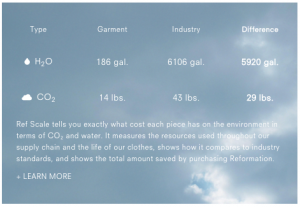Founded in 2009, Reformation is a clothing brand where “fashion and sustainability coexist”. The company has implemented many internal structures to ensure that the clothing they produce is sustainable, keeping resources, people, and cost in mind. For example, they sell directly online and in their own stores, eliminating middlemen and their corresponding markups. Reformation owns its manufacturing operations, keeping the production process under their control to ensure high quality and environmental standards are met. Their facilities are also designed to reduce water and energy waste. These are just some of the strategies that Reformation has integrated into their operations to meet their goal of raising awareness about the impact that the fashion industry has on the environment.
When I first heard of Reformation, it was not because of their sustainable and environmental practices… it was because of their product. When I began clicking through their website, browsing dresses and sweaters, I noticed a different type of labeling. Each product has a RefScale, which measures different

RefScale Screenshot from the Sabina Dress highlights the water and carbon dioxide required to produce the dress.
indicators showing the environmental impact of producing each piece. For example, the Sabina Dress took 186 gallons of Water, and 14 pounds of Carbon Dioxide to create. The Ref Scale also compares the resources used on that garment to the industry average, and the difference between the two. I was surprised to see this scale, because I initially thought that it would negatively effect how I thought about the product. However, once I began looking at the RefScale closer, I realized it is also a good marketing strategy, as it shows how Reformations products are outstanding in resource use compared to others in the industry. It also highlights their transparency as a company in regards to their operations.
I discovered this unique labeling after reading the class preparation piece on how companies are putting the product at the heart of sustainable business, and moving away from sustainable operations and cost goals as their primary focus. Reformation is creating sustainable products by innovating their marketing strategy to share resource indicators. The company is first providing desirable pieces of clothing, and secondly highlighting the sustainable aspect, which supports the foundation of sustainable marketing that we have looked at in class.
P.S. Reformation is a Benefit Corporation, too!
Great share Mina! This is the first time I’ve heard of Reformation and the biggest standout after quickly browsing their website is that these look like pieces people will WANT to buy. Visually, the clothes are trendy and modern…and they also have the sustainability report card like you mentioned. Because of these two aspects they appeal to a broader target market, first are for women who want the latest clothing and styles offered directly off of a Tumblr-esque website and secondly are people directly seeking the environmental impact reports. For the first demographic, seeing the sustainability report under the picture of a dress may be the first time it occurs to a consumer that creating clothes takes a lot of resources. Now waiting for them to release Men’s clothing…
It’s fantastic that a company even in the fashion industry, which has traditionally been extremely wasteful, has embraced transparency and being open to their customers about their resource use in all of their products.
The fact that one of their dresses takes so much water to make, and that ends up being a positive compared to the industry average, not only showcases the need for more efficiency in the market, but also allows the company to spark a conversation among those purchasing its goods, and makes people think more about the garments they wear and the resources that go into them.
It’s excellent that a company is focusing on internal sustainability and eliminating all those between them and the consumer, which will also give them better feedback into how they’re perceived.